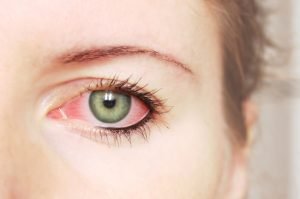Pink Eye
Pink eye, or conjunctivitis, can be caused by lots of conditions, including allergies, infection, contact lenses, and eye injury. Basically, when the eye becomes irritated, it gets red or pink due to inflammation, or swelling, of the conjunctiva.

Signs and Symptoms of Pink Eye:
Causes of Pink Eye
Viral Conjunctivitis is the most contagious form of pink eye. It usually occurs during or after a person has a cold or the flu. It can be spread from one person to another the same way that a cold is spread, by hand to eye, nose, or mouth contact. Avoiding contact with sick people, keeping your hands clean, and not touching your eyes, nose, mouth, or face can help prevent the spread of infection. If someone in your household is sick, try not to share their pillowcases, towels, or washcloths. The most common eye symptoms of viral conjunctivitis are pink, tired, watery, itchy, or sticky eyes along with head, eye, or body aches, and light sensitivity.
Bacterial Conjunctivitis is one of the most common causes of pink eye in contact lens wearers and in children. It usually is not contagious to other people, but can spread from one eye to the other if the infected eye is touched or rubbed a lot. Mattered eyelids, goopy discharge, and a sudden onset of redness are the most common eye symptoms with bacterial conjunctivitis.
Allergic Conjunctivitis may be the only sign of an allergy that a person may have, but most often allergic pink eye accompanies the other common allergy symptoms of a runny nose, scratchy throat, sinus or nasal congestion, cough, or asthma. In fact, sometimes people that are experiencing a mild allergic reaction actually think that they have a cold because the symptoms of allergies can mimic the symptoms of a common cold. Pink eye due to allergies can be triggered by contact lens wear, pollen, animals, foods, chemicals, dust, smoke, and wind. Itching, watering, white or stringy discharge, and redness are the most common eye symptoms of allergic conjunctivitis.
Episcleritis is pink eye caused by swelling and redness of the white part of the eye, or episclera, which is located directly under the conjunctiva. Episcleritis can make the entire eye red, or the redness can be from a wedge of swelling in just one section. The eye is usually sore to the touch, light sensitive, and a brow ache or headache often accompanies episcleritis, which is not contagious.
Inflammatory Conjunctivitis is pink eye caused by some irritation to the eye such as contact lens over wear, getting hit in the eye, dust, dirt, or chemical exposure (fumes, liquid, or solids), excessive rubbing of the eye, crying, not getting enough sleep, and dryness of the eye (from staring at a computer, or being in a windy or drafty place). Some common symptoms of inflammatory conjunctivitis are blurry vision, sore, red, and swollen eyes.
Pink Eye Treatment
The treatment of pink eye depends first on identifying its cause, which is usually simple and straightforward. Sometimes pink eye can be caused by more than one condition occurring at the same time, such as inflammatory conjunctivitis from contact lens over wear and seasonal allergic conjunctivitis.
A careful and thorough examination by your eye doctor is very important when you have pink eye to determine if your pink eye is contagious or can damage the eye. By looking at the eyes with a special light biomicroscope, called a slit-lamp, the best treatment can be recommended.
For example, your eye doctor will recommend specific eye drops, such as for allergies or infection to help the redness go away and ways to treat the underlying condition which created the redness in the first place. So that it doesn’t come back or spread.
Some eye drops require a prescription, while others may be purchased without a prescription, or over-the-counter. Currently, the best eye drops for pink eye are prescription only, although some of the over-the-counter allergy and lubricant drops work well on some eyes. Your doctor may in fact recommend one of these.
But, using the wrong eye drops may irritate or burn the eyes and make the eyes feel or look worse. So it’s best to see your eye doctor in order to find out the exact cause of your pink eye and to get the most effective eye drops and treatment for your eyes.
If you have a potentially vision threatening infection, medicated eye drops (or ointment) will be prescribed and your doctor will closely watch your eyes during the healing process. Depending on the exact cause of pink eye, treatment may last from as little as a few days to weeks, or even months! Fortunately, most treated cases of mild pink eye resolve within one week.
Because contact lenses can worsen pink eye, it is best to completely avoid contact lens wear while the eyes are healing. It’s a good idea for all contact lens wearers to always have a current glasses prescription handy, just in case an infection occurs.
